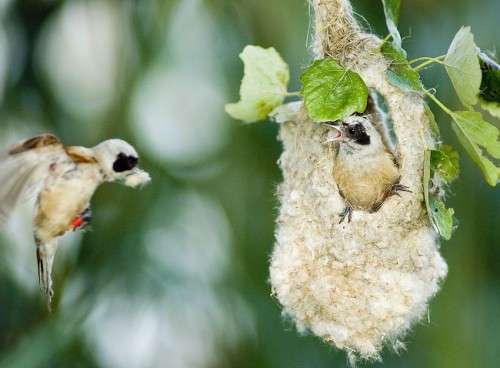Meet the polygamous birds that don’t hang around

(PhysOrg.com) -- Researchers from the University have established a mathematical model that goes some way to explain the very strange mating behaviour of the tiny Penduline tit.
This misbehaving European bird has a unique attitude to relationships, often resulting in fertilised eggs being abandoned and partners being ‘divorced’.
The male of the species starts the mating process by building an extremely sophisticated nest that hangs, like a pendulum, between forked tree twigs.
However, in a move that human men may sympathise with, the male bird leaves the finishing touches of the nest until a potential mate arrives. He uses the good nest foundations that he has built to lure her in, and then works with her to complete the dwelling to her specifications.
After completing the nest together, which can take up to two weeks and is lined with a couple of centimetres of soft cushioning to keep the eggs warm, in what appears a heartless move either the male or the female will ‘divorce’ its partner and abandon the nest.
Scientists have been baffled by this strange behaviour for decades, but now researchers have established a model that helps to explain the bird’s callous behavior.
Professor Tamas Szekely, from the University’s Biodiversity Laboratory in the Department of Biology & Biochemistry, has led the research. He said: “There is no logic to decide which parent leaves the nest; before this project all we knew for sure was that on no account did both parents stay and rear the young.
“Both parents have the same capabilities when it comes to raising their offspring, so the gender of the remaining bird makes no difference to the welfare of the chicks.
“The parent that leaves the nest will usually go on to mate again, with each ‘divorcing’ parent taking up to four or five new mating partners during a four month season!”
In order to explain the strange mating behaviour of the birds the researchers looked to calculate whether there was a biological benefit to either parent staying with the nest while the other left.
Professor Szekely said: “We tried to calculate how many offspring were produced in each circumstance – when the mother left, when the father left, or when both parents left the nest.
“However, because the bird that leaves can go on to have additional breeding partners during the course of the season, simple mathematical calculations aren’t possible.”
This complication led the researchers to explore game theory models – a mathematical method for analysing calculated circumstances where an individual’s success is based upon the choices of others.
Biodiversity Laboratory PhD research student Dr. Rene van Dijk, now a post-doctoral research associate at the University of Sheffield, tested game theory models against the birds’ behaviour.
Dr. van Dijk said: “The most applicable game to the birds mating behavior was the ’snowdrift game’ – used widely to explain the evolution of human cooperation.
“The game states that in a snowdrift, if two vehicles were stuck and their survival depended on them tunnelling to reach one-another, each would have equal gain from the digging of a tunnel. However each could also wait until the other party dug the tunnel, therefore eliminating any personal effort while maintaining their claim to the benefit.
“The behavior of the birds is somewhat similar to this – they each gain genetically from breeding, but each bird could also gain from leaving this nurturing stage to their partner and instead start breeding again with another bird. We used the model to predict the behaviour of a population of birds and on measuring the observed reality we found it to be very similar.
“The birds therefore gamble on whether or not the other parent will stay with the offspring and raise them. The parent that remains puts in the most effort and loses out on the opportunity of further breeding during the season, but both parents gain a benefit.
“In some cases the gamble doesn’t pay off, with both parents leaving after the eggs are laid resulting in the nest being unsuccessful. However both parents are making the gamble that during a whole breeding season, some of their partners will make the decision to stay with the nest when they move on.”
The research highlighted that the only difference between the result of the mother’s and the father’s care is that the mother’s clutch will eventually be larger as she continues to lay fertilised eggs following the departure of the father. However, this bears no testament to either parent’s ability to raise the chicks successfully.
Professor Szekely added: “The real beauty of this project was in demonstrating that not only can we use this method to develop a scientific understanding of animal behavior, but that we can do this in situations where the particular behaviour appears to be quite simply crazy. Having proven that this technique works there are wide potential applications for further studies.”
The research was carried out in collaboration with the University of Groningen in the Netherlands, and Eotvos Lorand University in Hungary. Findings have been published this week in the journal ‘Proceedings of the Royal Society: Biological Sciences’.
Penduline tits are water-loving birds often seen in marsh areas and along rivers and canals. Their breeding season lasts for four months, from April through to July. The birds move to forest areas to breed, building pendulum-like nests hanging from the trees. The tits are common throughout continental Europe and a number of non-breeding migrant birds are spotted in the UK each year.
Provided by University of Bath




















